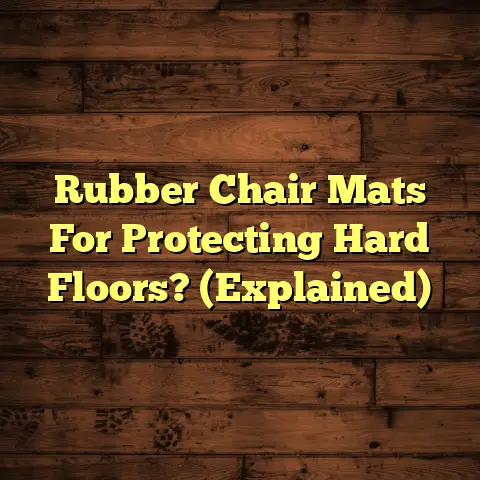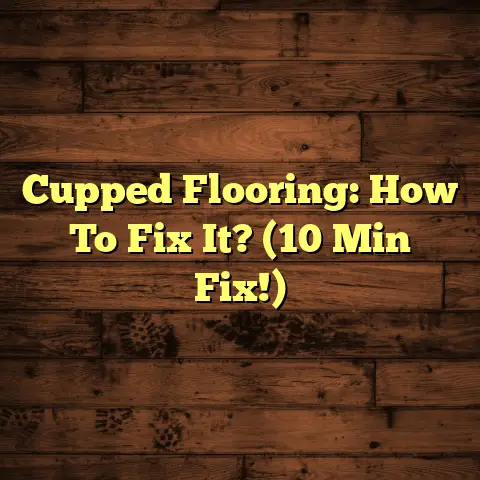How Long Vinyl Flooring Last? (1 Sign, Replace!)
It’s durable, stylish, and relatively affordable. But like any flooring, it doesn’t last forever.
So, how long does vinyl flooring last? And how do you know when it’s time to replace it?
Let’s dive in and get you the answers you need!
Introduction: Embracing Lifestyle Needs
with Vinyl Flooring
Modern living is all about blending comfort, style, and practicality. We want spaces that look great.
But they also need to stand up to the rigors of daily life. That’s where vinyl flooring shines.
I’ve seen vinyl transform homes for busy families. Also for pet owners, and those who love a sleek. Minimalist look. It’s incredibly versatile!
But here’s the thing: knowing how long your flooring will last is crucial. It helps you maintain a beautiful and functional home.
Plus, it prevents unpleasant surprises down the road. So, let’s explore the lifespan of vinyl flooring. This ensures you’re making smart, informed choices!
Section 1: The Basics of Vinyl Flooring
1.1 What is Vinyl Flooring?
Vinyl flooring is a synthetic flooring option made from several layers of different materials. These include PVC vinyl, plasticizers, and pigments.
These layers are fused together to create a durable, water-resistant, and visually appealing surface.
Think of it as a high-tech sandwich of flooring goodness!
There are different types of vinyl flooring. These include luxury vinyl tile (LVT), vinyl sheet, and vinyl planks. Each has its own unique features.
Luxury Vinyl Tile (LVT) is designed to mimic the look of natural materials like wood or stone.
It comes in individual tiles or planks, offering realistic textures and patterns. It’s super durable.
Vinyl Sheet comes in large rolls. This makes it virtually seamless. It’s great for bathrooms and kitchens.
Where water resistance is key. It’s also budget-friendly!
Vinyl Planks are similar to LVT but come in plank form. This makes them ideal for replicating hardwood floors.
Modern vinyl flooring uses advanced manufacturing techniques. This creates realistic textures and visuals.
Digital printing technology allows for incredibly detailed patterns. This makes it hard to tell the difference between vinyl and natural materials. It’s wild!
1.2 Types of Vinyl Flooring
Let’s quickly break down the pros and cons of each type:
- Luxury Vinyl Tile (LVT):
- Pros: Realistic appearance, durable, water-resistant, comfortable underfoot.
- Cons: Can be more expensive than other vinyl options, more challenging to install.
- Vinyl Sheet:
- Pros: Cost-effective, water-resistant, easy to install, seamless appearance.
- Cons: Less realistic appearance, can be susceptible to tears and punctures.
- Vinyl Planks:
- Pros: Mimics hardwood, easy to install (especially click-lock types), durable, water-resistant.
- Cons: Can be more expensive than sheet vinyl, may require a subfloor.
Each type offers different aesthetic options. You can find vinyl that looks like hardwood, stone, or tile.
The designs are endless! Durability and maintenance also vary. This depends on the type and quality of the vinyl.
Section 2: Average Lifespan of Vinyl Flooring
2.1 Standard Lifespan Estimates
So, how long can you expect your vinyl flooring to last? On average, vinyl flooring lasts between 10 to 20 years.
But this can vary depending on several factors. I’ve seen some last longer, and others need replacing sooner.
It really depends on how well you take care of it.
Manufacturers and flooring experts generally agree on this lifespan. High-quality LVT, for example, can easily last 20 years or more with proper care.
Sheet vinyl, on the other hand, might need replacing sooner. Especially in high-traffic areas.
2.2 Factors Affecting Longevity
Several key factors influence how long your vinyl flooring will last. Let’s break them down:
- Quality of Materials Used: Higher-quality vinyl is more durable and resistant to wear and tear. Cheaper options might look good initially. But they often degrade faster.
- Installation Methods: Professional installation ensures the flooring is properly installed and sealed. This prevents moisture damage and extends its lifespan. DIY installations can be tricky. Mistakes can lead to premature wear.
- Environmental Conditions: High humidity and temperature fluctuations can affect the adhesive and cause the vinyl to warp or peel. Maintaining a stable environment is key.
- Level of Foot Traffic: Areas with heavy foot traffic, like hallways and kitchens, will naturally experience more wear and tear. Using rugs and mats in these areas can help protect the flooring.
Section 3: The Sign of Replacement
3.1 Identifying Wear and Tear
Okay, so how do you know when it’s time to replace your vinyl flooring? The single most critical sign is significant wear or damage.
I’m talking about damage that affects the flooring’s appearance and functionality. Let’s look at some common types of damage:
- Scratches: Minor scratches are normal, but deep, widespread scratches can make the floor look worn and unattractive.
- Dents: Heavy furniture or dropped objects can cause dents in the vinyl. These dents can be difficult to repair and can worsen over time.
- Discoloration: Exposure to sunlight or harsh chemicals can cause the vinyl to fade or discolor. This can make the flooring look uneven and old.
- Peeling: If the vinyl starts to peel away from the subfloor, it’s a clear sign that the adhesive has failed. This can create tripping hazards and lead to further damage.
3.2 Impact of Lifestyle on Wear and Tear
Your lifestyle plays a huge role in how quickly your vinyl flooring wears down. For example, families with children and pets often see quicker degradation.
Think about it: kids running around, toys being dropped, pets scratching and shedding. It all adds up!
On the other hand, a quiet couple with no pets might find their vinyl flooring lasts much longer.
I once worked with a family who had three large dogs. They had installed beautiful vinyl plank flooring.
But within a few years, the floor was covered in scratches and dents. They ended up replacing it much sooner than expected.
In contrast, I have another client. They are an elderly couple. Their vinyl sheet flooring looks almost brand new after 15 years. It’s all about lifestyle!
Section 4: Maintenance Tips to Extend Lifespan
4.1 Proper Cleaning Techniques
Proper cleaning is essential for maximizing the lifespan of your vinyl flooring. Here are some tips:
- Sweep or vacuum regularly: This removes dirt and debris that can scratch the surface.
- Use a damp mop: Avoid soaking the floor, as excess water can damage the adhesive.
- Use a pH-neutral cleaner: Harsh chemicals can damage the vinyl. Look for cleaners specifically designed for vinyl flooring.
- Avoid abrasive cleaners and scrub brushes: These can scratch and dull the surface.
- Clean spills immediately: This prevents stains and damage.
4.2 Preventative Measures
In addition to regular cleaning, here are some preventative measures you can take:
- Use rugs in high-traffic areas: This protects the flooring from wear and tear.
- Apply felt pads under furniture: This prevents scratches and dents.
- Control humidity levels: Use a dehumidifier to maintain a stable environment.
- Avoid direct sunlight: Use curtains or blinds to protect the flooring from fading.
- Trim your pets’ nails: This reduces scratching.
Section 5: When to Invest in New Vinyl Flooring
5.1 Cost vs. Value Analysis
Replacing vinyl flooring can be a significant investment. But it’s important to weigh the costs against the benefits.
If your flooring is severely damaged. And it affects the overall appearance of your home. Then replacement might be the most cost-effective option in the long run.
Think about it: old, worn-out flooring can decrease your home’s value. New flooring can increase it.
Plus, newer vinyl flooring options are often more durable and stylish than older ones. You might even save money on energy bills with better insulation!
5.2 Emotional and Functional Considerations
Beyond the financial aspects, there’s also the emotional and functional side of things. How does your flooring make you feel?
Does it make your home feel fresh and inviting? Or does it make you feel embarrassed and uncomfortable?
A fresh, aesthetically pleasing environment can enhance your daily living. It can contribute to a sense of well-being. After all, your home should be a place where you feel happy and relaxed!
Conclusion: Making Informed Choices for Your Home
So, there you have it! Understanding how long vinyl flooring lasts and recognizing the key sign for replacement is crucial for maintaining a beautiful and functional home.
Remember, the lifespan of your vinyl flooring depends on various factors. These include the quality of materials, installation methods, environmental conditions, and your lifestyle.
By following proper maintenance tips and being aware of the signs of wear and tear. You can extend the life of your flooring and make informed decisions about when to replace it.
Assess your own flooring and lifestyle needs. This empowers you to make choices that best suit your living environment.
Vinyl flooring can be a durable and stylish choice. But awareness of its lifespan helps you maintain your space’s beauty and functionality over time.





